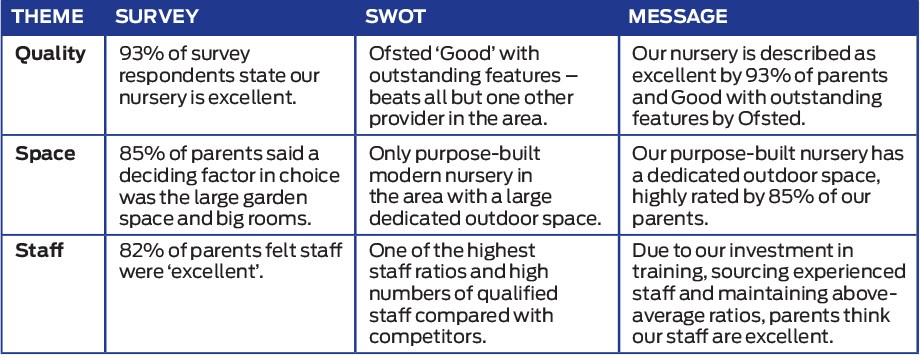Nursery Management: Marketing - All part of the plan
Gordon Kay
Monday, March 21, 2016
Marketing may not be top of the priorities list, but with more financial pressures on the way in the form of the 30 hours and National Living Wage, it may come into its own, writes Gordon Kay

Your nursery is in the middle of an ever-changing childcare market. In your area in the past year it is likely that some nurseries have changed services or offered new ones, been re-graded by Ofsted and changed prices, or even opened or closed.
Having a strong marketing plan means you have an idea of what is going on around you, can see where you sit in the market and make decisions to ensure your nursery is best placed to find new clients. It is about meeting your goals.
A marketing plan fits into your wider business plan, which would consider overall strategy, financial plans and cashflow, service range, and operational aims such as staffing and building works and how they work together. It is a useful document to show potential financial backers who are bound to ask about marketing as a means of assessing the risk of return from their investment with you. This is also true if you are bidding for grants.
There are broadly four stages to creating one:
- Working out where you are now (research and analysis)
- Deciding where you want to be (objectives and messaging)
- Working out how you get there (promotions)
- Setting achievement goals (evaluation) that you can check against next year.
So, how to begin? Well, if I opened a nursery and wanted to devise a marketing plan, this is how I would do it:
1. Where are we now?
This involves dual-pronged research: surveying your current parents and a SWOT analysis.
1.1 Who are my customers?
Find out what parents and carers think of your nursery by surveying them (online tool Survey Monkey is free as long as you ask 10 questions or fewer). Ask standard questions such as their postcode, age and number of sessions they book so you can see the views of different groups (segments) of your clients and what they might want.
Also make sure to ask the key marketing questions of how they initially found out about the nursery, and what information sources they used to find out details, such as websites and social media.
(You could also use this to gain information on key related issues such as whether parents will be eligible for the extra 15 free hours that the Government is offering from next year).
From this you see the strengths and weaknesses of your nursery from a parent’s perspective.
1.2 Who are my future customers?
Do you understand your potential market? You can find out the number of 0-5s in your area by contacting the children’s services department of your local council, or by searching the Office for National Statistics website.
One nursery that did this found that most of its customers came from a single postcode area, which was used to focus its promotion.
1.3 SWOT analysis
A SWOT analysis looks at your strengths, weaknesses, opportunities and threats. Strengths and weaknesses are ones you can have some influence over, such as size, staffing, Ofsted report, facilities or client satisfaction. Opportunities and threats are those you have no influence over, such as government changes to childcare provision, and competitors changing their services or opening or closing. You match the strengths with the opportunities to form priorities, and match the weaknesses and threats as risks that need consideration.
You will need to research your competitors to do this. Look at all providers (or a minimum of five) within a one-mile radius of the nursery if you are in a town or city location, or five miles in the countryside. See how and what they provide.
Compare price (particularly per hour, which you may have to calculate), product (range of services offered, Ofsted report), place (location, closeness to transport links, access to parks, parking), promotion (competitor website, social media, advertising, press coverage) and people (quality of staff, ascertained from the settings’ Ofsted reports and website).
This can be fed into a SWOT analysis like so: ‘Nursery A has an Outstanding rating from Ofsted; has been established for some years in purpose-built facilities with a high staff-child ratio [these are all strengths]. However, because of this they charge relatively high fees. They are also not in a central location [weaknesses].
‘If Nursery B, which also has high prices, puts fees up or closes, this is an opportunity for Nursery A to benefit from the rise in demand by targeting advertising in the area. However, if Nursery C, which is in a more central location, employs one more early years teacher, this will be a threat.’

2. Marketing objectives – where do we want to go?
You need to be realistic in your marketing objectives; limited time and resources mean you set goals that you feel are achievable. Most nurseries’ key objectives are to increase or maintain occupancy levels.
2.1 Create ‘key messages’
Key messages are positives which ‘sell’ the nursery. The table below shows how to bring together the strengths from your SWOT, and the positive feedback from your survey. Ideally there should be no more than five messages that are real, clear and distinctive.
2.2 Promote the message
These key messages should then be shown consistently across your website, leaflets, adverts and social media. Back up your messages with real comments from parents, real photography and, if you can afford it, a film.
3. The marketing mix – which tools to use
3.1 Websites and social media
Websites and social media are important, but unless your website has good ‘search-engine optimisation’, your nursery may never appear high enough in a Google search to be visible. Test this by typing in an obvious search term such as ‘nurseries in xx’ – xx being your area, and see where you appear. To boost your rankings, ensure your area and obvious search terms such as these appear clearly and prominently on your site.
You may also find it worthwhile appearing on national listings sites as this can help boost your rankings.
3.2 Print
Don’t forget print, particularly local newspapers, as these can offer cheap advertising deals. Leaflet places where potential parents might be: baby clinics, libraries, etc.
3.3 Word of mouth
Encourage your current parents to be ambassadors by offering free day sessions for each new parent they recruit. It could be more effective than an advert as it only costs when you get a result.
4. Evaluate
Ask all new enquirers where they heard about you. Survey yearly to see whether your priorities are the same or have changed. The whole process should be annual, and it should get easier as time goes on.
CASE STUDY
 Cherry Tree Nursery in Brighton wanted to increase its occupancy levels. A survey showed that the setting was seen as excellent by 92 per cent of parents, and most customers lived within a mile radius.
Cherry Tree Nursery in Brighton wanted to increase its occupancy levels. A survey showed that the setting was seen as excellent by 92 per cent of parents, and most customers lived within a mile radius.
Competitor analysis suggested that there were no other nurseries for half a mile in any direction, and Cherry Tree was the only full-time purpose-built setting out of 17 sampled. It had the most qualified staff compared with competitors which, along with high staff ratios, contributed to an Outstanding rating. However, the nursery’s location and low profile led to the applications not being as forthcoming as expected.
Recommendations suggested clearer messaging about high customer satisfaction, highly qualified staff, purpose-built facilities, and closeness to a major transport junction in the city. A review of messages and content was undertaken and new photography and a film were commissioned, which reflected these messages, backed by real comments from staff and parents. Cherry Tree now has a clearer idea of where it sits and is implementing new messages and content to raise its profile and increase numbers.
See Cherry Tree Nursery’s film at: bit.ly/1Tt0H2y
Gordon Kay is director of Tell Your Story Better, which works with small businesses including nurseries on their marketing communications. See www.tell-your-story-better.com





